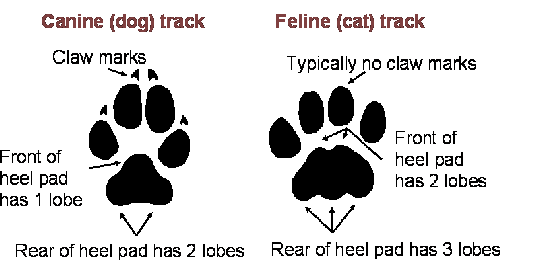This week, we're going to talk about what tracking is, and what kind of tracks to look for and what they mean.
What It Is
Tracking is a very underrated skill among folks who don't hunt. The obvious use of tracking is following game that you'd like to turn into tasty meat; the less-obvious, but probably more useful employment of this skill, is being able to determine what animals are in the area that may want to turn you into tasty meat. Whether you use your skills as a predator or to avoid becoming prey, the same basic elements apply.
At its core, tracking is the art and discipline of identifying and interpreting signs left behind by animals as they go about their regular routines.The most commonly thought of sign is a footprint, but other common signs such as scat or disturbed or damaged environmental bits. All of these parts combine to tell the story of what went where, and when.
What to Look For
Animal signs fit into three main categories: tracks or prints; scat; and disturbed environment. Signs are unique to various types of animals, and when taken as a whole, they will tell a great deal about the fauna around you.
The particular signs, and animals you find, will depend on the area you're in, and a good guidebook will give a comprehensive breakdown of the types of signs a particular animal leaves. My favorite guides are James Halfpenny's Scats and Tracks series. Scats and Tracks of the Desert Southwest happens to be the one that applies to my home are and favorite vacation spots, but there are guides for the whole country.
While a guide will give you great detail about the animals in your area, there are some universal constants in tracking that apply to the entire country.
Tracks
In general, a deeper track comes from a heavier animal.
A new track will have sharp, clean edges and more defined details. As a track ages, edges crumble and details wash out. After just a couple days, the detail can be almost entirely gone.
Different animal genera and species will make distinctly different tracks. For example, cat and dog tracks are very similar, but the differences between them are easily seen.
 |
| Picture from Michigan DNR. |
Deer and other wild herbivores have a split hoof. As with predators, a larger, deeper track means a larger animal. Herbivores are generally harmless, but if they feel threatened, they can be even more dangerous than a predatory animal: for instance, a fully grown moose weighs upwards of 1200 pounds, with massive antlers and sharp hooves. Such an animal rampaging through camp would be like having a car drive through it.
| Image from wildawareutah.org |
Tracks can also tell how fast an animal was moving. A slower-moving animal leaves tracks that have even, vertical sides; faster movement leaves a track with sloping edges as the foot rolls out of the track. Faster movement also means that tracks are spaced further apart.
| http://wildfound.weebly.com/tracking/basics-of-tracking-part-2-reading-prints |
Next week, we'll shoot the poop as we talk about scat.
Lokidude


No comments:
Post a Comment